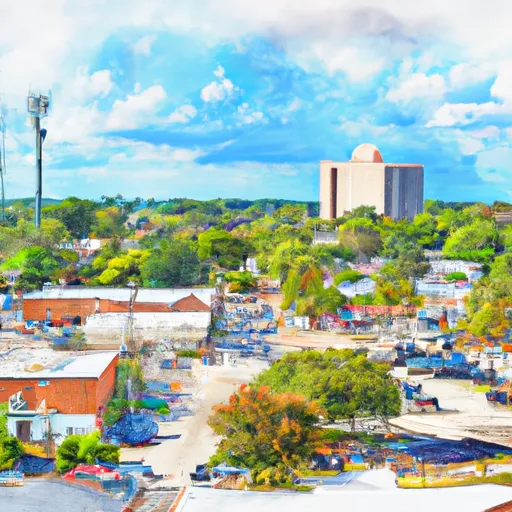-
 Snoflo Premium
Snoflo Premium
Get unlimited access to all our content
With no Ad interruptions! - Start Your Free Trial Login with existing account
Salem
Eden Index
Climate
7.4
•
Recreation
2.8
•
Community
•
Safeguard
3.9/10

Salem, Florida is a beautiful town located in north-central Florida, known for its pleasant climate, diverse hydrology constituents, and numerous outdoor recreation opportunities. The town experiences a humid subtropical climate, with hot and humid summers and mild winters. Summers are characterized by frequent thunderstorms, providing relief from the heat. Winters are mild, with occasional cold fronts bringing cooler temperatures. The region boasts an array of hydrology constituents, including numerous lakes and springs. Lake George, one of the largest lakes in Florida, offers excellent boating, fishing, and water skiing opportunities, while Silver Glen Springs and Salt Springs are popular for swimming, snorkeling, and picnicking.
Outdoor enthusiasts in Salem can explore the nearby Ocala National Forest, showcasing a diverse landscape with hiking and biking trails, camping sites, and abundant wildlife. The area is also renowned for its excellent birdwatching opportunities. Furthermore, the St. Johns River, which flows through Salem, presents additional options for boating, fishing, and wildlife observation. With its favorable climate, diverse hydrology, and ample outdoor recreational activities, Salem, Florida, is a wonderful destination for nature lovers and adventure seekers alike.
What is the Eden Index?
The Snoflo Eden Index serves as a comprehensive rating system for regions, evaluating their desirability through a holistic assessment of climate health, outdoor recreation opportunities, and natural disaster risk, acknowledging the profound impact of these factors on livability and well-being.
Climate Health Indicator (CHI): 7.4
Salem receives approximately
1462mm of rain per year,
with humidity levels near 89%
and air temperatures averaging around
20°C.
Salem has a plant hardyness factor of
8, meaning
plants and agriculture in this region tend to thrive here all year round.
By considering the ideal temperature range, reliable water supplies, clean air, and stable seasonal rain or snowpacks, the Climate Health Indicator (CHI) underscores the significance of a healthy climate as the foundation for quality living.
A healthy climate is paramount for ensuring a high quality of life and livability in a region, fostering both physical well-being and environmental harmony. This can be characterized by ideal temperatures, reliable access to water supplies, clean air, and consistent seasonal rain or snowpacks.
Weather Forecast
Streamflow Conditions
Aucilla-Waccasassa
Area Rivers
Aucilla-Waccasassa
Snowpack Depths
Aucilla-Waccasassa
Reservoir Storage Capacity
Aucilla-Waccasassa
Groundwater Levels
Recreational Opportunity Index (ROI): 2.8
The Recreational Opportunity Index (ROI) recognizes the value of outdoor recreational options, such as parks, hiking trails, camping sites, and fishing spots, while acknowledging that climate plays a pivotal role in ensuring the comfort and consistency of these experiences.
Access to outdoor recreational opportunities, encompassing activities such as parks, hiking, camping, and fishing, is crucial for overall well-being, and the climate plays a pivotal role in enabling and enhancing these experiences, ensuring that individuals can engage in nature-based activities comfortably and consistently.
Camping Areas
| Campground | Campsites | Reservations | Toilets | Showers | Elevation |
|---|---|---|---|---|---|
| Horseshoe Beach County Park | None | 9 ft | |||
| Grassy Pond Military | None | 171 ft | |||
| Paulk City Park | 25 | 335 ft | |||
| Reed Bingham State Park | None | 203 ft |
Catastrophe Safeguard Index (CSI):
The Catastrophe Safeguard Index (CSI) recognizes that natural disaster risk, encompassing floods, fires, hurricanes, and tornadoes, can drastically affect safety and the overall appeal of an area.
The level of natural disaster risk in a region significantly affects safety and the overall livability, with climate change amplifying these risks by potentially increasing the frequency and intensity of events like floods, fires, hurricanes, and tornadoes, thereby posing substantial challenges to community resilience and well-being.
Community Resilience Indicator (CRI):
The Community Resilience Indicator (CRI) recognizes that education, healthcare, and socioeconomics are crucial to the well-being of a region. The CRI acknowledges the profound impact of these elements on residents' overall quality of life. By evaluating educational resources, healthcare accessibility, and economic inclusivity, the index captures the essential aspects that contribute to a thriving community, fostering resident satisfaction, equity, and social cohesion.

